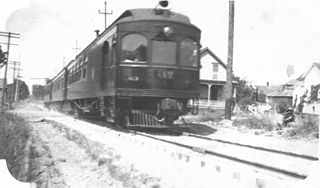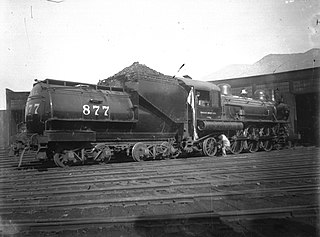
Oregon City is the county seat of Clackamas County, Oregon, United States, located on the Willamette River near the southern limits of the Portland metropolitan area. As of the 2020 census, the city population was 37,572. Established in 1829 by the Hudson's Bay Company, in 1844 it became the first U.S. city west of the Rocky Mountains to be incorporated.

Canby is a city in Clackamas County, Oregon, United States. The population was 18,171 at the 2020 census. It is along Oregon Route 99E, 2 miles (3 km) northeast of Barlow.

Toledo is a city located on the Yaquina River and along U.S. Route 20 in Lincoln County, in the U.S. state of Oregon. The population was 3,465 at the 2010 census. The city was a 2009 All-America City Award finalist.

The Oregon Electric Railway (OE) was an interurban railroad line in the U.S. state of Oregon that linked Portland to Eugene. Service from Portland to Salem began in January 1908. The Spokane, Portland and Seattle Railway purchased the system in 1910, and extended service to Eugene in 1912. Regular passenger service in the Willamette Valley ended in May 1933. Freight operations continued and the railway survived into the 1990s, ultimately as a Burlington Northern feeder. Operation as an electric railroad ended July 10, 1945.

The Lewis and Clark National Historical Park, located in the vicinity of the mouth of the Columbia River, commemorates the Lewis and Clark Expedition. Administration of the park, which includes both federal and state lands, is a cooperative effort of the National Park Service and the states of Oregon and Washington. The National Historical Park was dedicated on November 12, 2004.

The Oregon Short Line Railroad was a railroad in Wyoming, Idaho, Utah, Montana and Oregon in the United States. The line was organized as the Oregon Short Line Railway in 1881 as a subsidiary of the Union Pacific Railway. The Union Pacific intended the line to be the shortest route from Wyoming to Oregon and the Pacific Northwest. Construction was begun in 1881 at Granger, Wyoming, and completed in 1884 at Huntington, Oregon. In 1889 the line merged with the Utah & Northern Railway and a handful of smaller railroads to become the Oregon Short Line and Utah Northern Railway. Following the bankruptcy of Union Pacific in 1897, the line was taken into receivership and reorganized as the Oregon Short Line Railroad (“OSL”). The OSL became a part of the Union Pacific System in the Harriman reorganization of 1898.

The Niles Depot Museum is located in the former Southern Pacific Railroad colonnade-style passenger depot built in 1901, and freight depot, located in the Niles District of Fremont, California. The museum is operated by the Niles Depot Historical Foundation and features exhibits and artifacts about area railroads, including the early Southern Pacific Railroad and Western Pacific Railroad, as well as the current Union Pacific Railroad and Amtrak.

Goleta Depot is a train station building in Goleta, California constructed by the Southern Pacific Railroad in 1901, as part of the completion of the Coast Route linking Los Angeles and San Francisco. It is a Southern Pacific standard design Two Story Combination Depot No. 22. The building is listed on the National Register of Historic Places and the California Register of Historical Resources and is the centerpiece of the South Coast Railroad Museum.

The Los Angeles and Salt Lake Railroad was a rail company in California, Nevada, and Utah in the United States, that completed and operated a railway line between its namesake cities, via Las Vegas, Nevada. Incorporated in Utah in 1901 as the San Pedro, Los Angeles and Salt Lake Railroad, the line was largely the brainchild of William Andrews Clark, a Montana mining baron and United States Senator. Clark enlisted the help of Utah's U.S. Senator Thomas Kearns, mining magnate and newspaper man, to ensure the success of the line through Utah. Construction of the railroad's main line was completed in 1905. Company shareholders adopted the LA&SL name in 1916. The railway was also known by its official nickname, "The Salt Lake Route", and was sometimes informally referred to as "The Clark Road". The tracks are still in use by the modern Union Pacific Railroad, as the Cima, Caliente, Sharp, and Lynndyl Subdivisions.
The names Southern Pacific Depot, Southern Pacific Railroad Station, Southern Pacific Railroad Depot, and variations, apply to a number of train stations operated by the Southern Pacific Railroad:

Eugene station is a train station in Eugene, Oregon, United States. It is served by Amtrak's Coast Starlight passenger train and is the southern terminus of the Amtrak Cascades corridor. The station is also served by the Cascades POINT bus service.

Salem station is an Amtrak train station in Salem, Oregon, United States. It is served by Amtrak Cascades corridor trains going to and from Portland, Oregon, as well as the long-distance Coast Starlight. Greyhound Lines and some regional buses also stop at the station.

The Nevada–California–Oregon Railway was a 3 ft narrow gauge railroad originally planned to connect Reno, Nevada, to the Columbia River. However, only 238 mi (383 km) of track were laid so service never extended beyond Lakeview, Oregon. Because of the company’s reputation for mismanagement, it was often called the "Narrow, Crooked & Ornery" railroad.

The Nevada-California-Oregon Railroad Depot was built by the Nevada-California-Oregon Railway (NCO) in 1910 in Reno, Nevada. It is Nevada Historical Marker number 210. It is also listed in the National Register of Historic Places. The building today is used for a restaurant and microbrewery called The Depot Craft Brewery Distillery

The Southern Pacific Red Electric Lines, also known simply as the Red Electric, was a network of interurban passenger train services operated by the Southern Pacific Railroad in the Willamette Valley of the U.S. state of Oregon from 1914 to 1929. The service got its name from the bright red color of its cars. Despite its short history, among West Coast interurbans it was unique, and it was considered the finest such system in the Pacific Northwest. It was the only major electric interurban railroad converted from steam to electric passenger use. It was also one of few systems using all-steel equipment, and one of the largest 1500-volt systems in the country.

The Lebanon Southern Pacific Railroad Depot is a former railway station located in Lebanon, Oregon, Oregon, listed on the National Register of Historic Places. It was constructed in 1908 for use by the Southern Pacific Company (SP), to replace an 1880 depot that had become too small for the amount of traffic it was handling. It is a Southern Pacific standard design, a One Story Combination Depot No. 23, which was intended to serve both freight and passenger traffic. The building ceased to be used by passenger services in the mid-1950s, after which it remained in use as a base for freight operations. The depot closed in 1985 and was then vacant for several years, until the City of Lebanon purchased it from SP in 1996. It was added to the NRHP in 1997.

Santa Susana Depot is a train station building located near the Santa Susana Pass in Simi Valley, California. Originally located on Los Angeles Avenue at Tapo Street, the depot opened in 1903. The station was named after the Santa Susana Mountains at the east end of the Simi Valley. The Southern Pacific Railroad used the double-"N" spelling of Susanna on the depot sign facing west, and the single-"N" spelling of Susana on the sign facing east. The Santa Susana Tunnel opened the next year, reducing the distance and transit time between Montalvo and Burbank on the Coast Route linking Los Angeles and San Francisco. Plans and construction for the building were based on Southern Pacific Railroad standard design Two Story Combination Depot No. 22. The depot served the community of Rancho Simi as a passenger station, telegraph office, and freight depot where farmers could deliver crops for shipping and pick up farming equipment delivered by the railroad.

The Nevada–California–Oregon Railway Passenger Station is a historic train station in Lakeview, Oregon, United States. It was built in 1912 by contractor I. A. Underwood from plans by architect Frederic DeLongchamps. It was the northern terminus of the Nevada–California–Oregon Railway. The Southern Pacific Railroad company owned and operated the depot from 1928 until 1975, when it was closed. Since 1978, the building has been used as a law office and later a private residence. Because of its importance to local history, the depot was listed on the National Register of Historic Places in 1983.

La Grande station is a train station located in La Grande, Oregon. It was built by the Union Pacific Railroad along its main line to Portland in 1930 and was later used by Amtrak's Pioneer until it was discontinued in 1997. The station building still stands and is listed as a National Register of Historic Places contributing property as the La Grande Railroad Depot, in the La Grande Commercial Historic District.


















